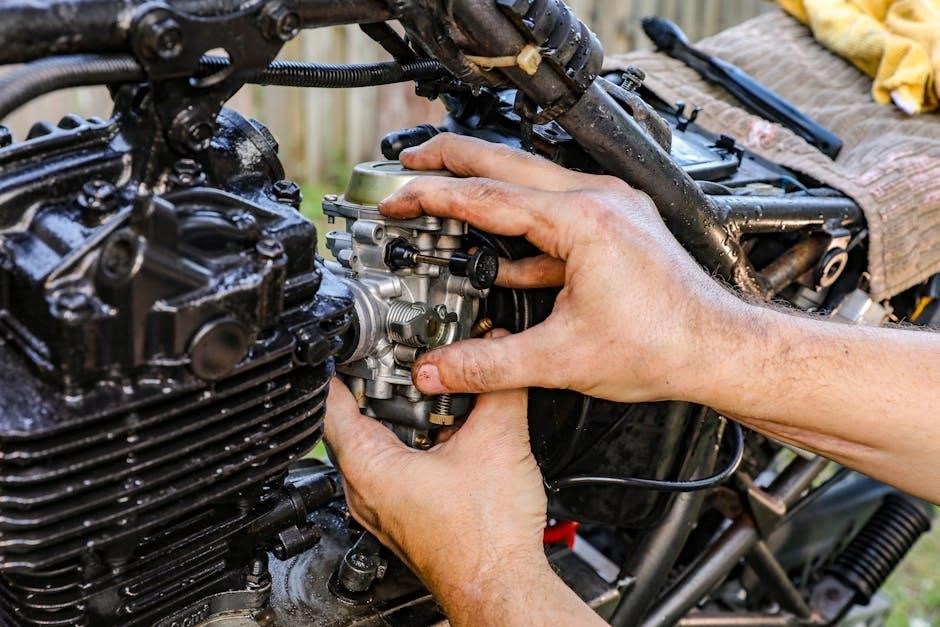The Common Remotely Operated Weapon Station (CROWS) is a critical component of the U.S. military, enabling remote operation of crew-served weapons from armored vehicles, enhancing combat effectiveness.
1.1 Overview of the CROWS System
The Common Remotely Operated Weapon Station (CROWS) is a advanced weapon system designed to enhance combat operations by enabling remote aiming and firing of crew-served weapons. It allows gunners to engage targets while protected inside armored vehicles, reducing exposure to hostile fire. The system is compatible with various weapons, including the Mk19 grenade launcher, M2 .50 Caliber Machine Gun, M240B, and M249 SAW. CROWS integrates seamlessly with multiple platforms, such as HMMWVs and Abrams tanks, ensuring versatility across missions. Its reliability and programmable features make it a critical asset for modern military operations, improving accuracy and operational effectiveness in dynamic environments.
1.2 Key Features and Benefits
The CROWS system offers enhanced operational capabilities through remote weapon control, improving safety and accuracy. It features programmable target tracking, night/day operation, and stabilization during vehicle movement. The system supports multiple weapon types, including the Mk19, M2 .50 Cal, M240B, and M249 SAW. Its modular design allows integration with various vehicle platforms, such as HMMWVs and Abrams tanks. CROWS reduces operator exposure to hostile fire, enabling precise engagement while protected. These features collectively enhance combat effectiveness, reliability, and versatility across diverse mission environments.

System Components
The CROWS system consists of two primary components: the Mount Component, which secures the weapon, and the Control Group Component, enabling remote operation and targeting.
2.1 Mount Component
The Mount Component of the CROWS system securely attaches to the host vehicle and holds the weapon in place. It is designed to accommodate various weapons, including the Mk19 grenade launcher, M2 .50 Caliber Machine Gun, M240B Machine Gun, and M249 Squad Automatic Weapon. This component ensures stability and alignment, allowing precise targeting and smooth operation during vehicle movement. Its robust construction withstands battlefield conditions while maintaining the weapon’s accuracy and reliability. The mount’s versatility enables integration with multiple vehicle platforms, from HMMWVs to Abrams tanks, enhancing the system’s operational flexibility.
2.2 Control Group Component
The Control Group Component is the operational hub of the CROWS system, allowing the gunner to remotely control the mounted weapon. It features a user-friendly interface with joysticks, buttons, and displays for targeting and firing. The control group includes a thermal camera, laser rangefinder, and zoom optics, enabling day/night operations and precise target acquisition. Operators can program target reference points and engage multiple targets efficiently. This component ensures seamless interaction between the gunner and the weapon, providing real-time feedback and enhancing combat effectiveness. Its advanced sensors and controls minimize operator exposure, maximizing safety during missions.

Compatible Weapons
The CROWS system is compatible with the Mk19 Grenade Launcher, M2 .50 Caliber Machine Gun, M240B Machine Gun, and M249 Squad Automatic Weapon, ensuring versatile firepower.
3.1 Mk19 Grenade Launcher
The Mk19 Grenade Launcher is a key weapon integrated with the CROWS system, offering high-volume firepower. It can fire up to 375 rounds per minute, providing suppressive and lethal effects. Mounted on various platforms, the Mk19 is ideal for engaging multiple targets, including personnel and lightly armored vehicles. Its compatibility with CROWS enhances operational safety by allowing gunners to operate from inside armored vehicles, reducing exposure to hostile fire. The system ensures precise targeting and rapid engagement, making it a versatile asset in modern combat scenarios.
3.2 M2 .50 Caliber Machine Gun
The M2 .50 Caliber Machine Gun is a powerful, crew-served weapon integrated with the CROWS system. Known for its heavy firepower, it delivers a high volume of accurate fire against personnel, vehicles, and fortifications. Compatible with the CROWS, the M2 allows operators to engage targets remotely while remaining protected inside armored vehicles. Its integration enhances precision and reduces operator exposure to hostile fire. The M2’s reliability and long-range capabilities make it a critical asset for suppressing enemy forces and providing cover during missions. Its use with CROWS ensures effective and safe operation in diverse combat scenarios.
3.3 M240B Machine Gun
The M240B Machine Gun is a 7.62mm, belt-fed, crew-served weapon integrated with the CROWS system. Known for its reliability and versatility, it provides sustained suppressive fire against enemy personnel and light vehicles. Compatible with CROWS, the M240B enables remote operation, allowing gunners to engage targets while protected inside armored vehicles. Its moderate caliber offers a balance between firepower and ammunition capacity, making it ideal for various combat scenarios. The M240B’s integration with CROWS enhances its effectiveness, ensuring precision and safety during missions. Its adaptability to different vehicle platforms further underscores its value in modern military operations.
3.4 M249 Squad Automatic Weapon
The M249 Squad Automatic Weapon (SAW) is a lightweight, 5.56mm, belt-fed machine gun integrated with the CROWS system. Designed for high-volume suppressive fire, it provides sustained firepower against enemy personnel and positions. Its compact design and moderate weight make it ideal for both infantry and vehicle-mounted operations. When paired with CROWS, the M249 enables remote operation, reducing gunner exposure to hostile fire; Its high rate of fire and compatibility with various platforms, such as the HMMWV and M1A2 Abrams, enhance its versatility in combat scenarios, ensuring reliable and precise target engagement capabilities.

Operational Features
The CROWS system offers advanced operational capabilities, including programmable target tracking, day/night operations, and stabilization during vehicle movement, ensuring precise and reliable weapon control in dynamic environments.
4.1 Programmable Target Tracking
The CROWS system features programmable target tracking, allowing operators to set reference points and sector surveillance. It automatically tracks targets with ballistic lead compensation, ensuring accurate engagement. Operators can program multiple locations for surveillance, enabling efficient monitoring of potential threats. This feature enhances situational awareness and reduces operator workload. The system’s ability to automatically adjust for target movement improves firing accuracy, making it highly effective in dynamic combat scenarios. This capability is crucial for maintaining operational superiority in modern battlefield conditions.
4.2 Night/Day Operations
The CROWS system supports seamless transitions between day and night operations, utilizing thermal imaging and low-light cameras for target acquisition in darkness. Operators can switch between visual and thermal modes, ensuring uninterrupted functionality. The system’s optics are equipped with magnification and focus adjustments, enabling precise targeting regardless of lighting conditions. This capability ensures 24/7 operational readiness, allowing forces to engage threats effectively in any environment. The integration of a laser range finder further enhances accuracy during nighttime missions, providing critical distance measurements for precise engagements. This feature is essential for maintaining tactical superiority in diverse combat scenarios.
4.3 Stabilization During Movement
The CROWS system features advanced stabilization technology, ensuring weapon accuracy even during vehicle movement. Gyroscopes and sensors detect motion, automatically adjusting the aim to maintain target alignment. This capability minimizes the impact of vehicle vibrations and sudden maneuvers, allowing precise engagements on-the-move. The stabilization system operates seamlessly across various terrains and speeds, enhancing operational effectiveness. It reduces operator fatigue and increases lethality by maintaining consistent targeting accuracy. This feature is critical for missions requiring rapid mobility and precise firepower, ensuring the CROWS system remains effective in dynamic combat environments.

Platform Integration
The CROWS system is designed for seamless integration on various military platforms, including HMMWVs and M1A2 Abrams tanks, ensuring versatility and reliability across different combat vehicles.
5.1 High Mobility Multipurpose Wheeled Vehicle (HMMWV)
The HMMWV is a primary platform for the CROWS system, offering enhanced mobility and protection. Its compact design allows seamless integration of the CROWS mount and control group, enabling remote weapon operation while maintaining vehicle agility. The system ensures crew safety by allowing gunners to operate from within the armored cabin. The HMMWV’s versatility makes it an ideal choice for deploying CROWS in diverse combat scenarios, from urban environments to rugged terrain. This integration maximizes the HMMWV’s combat effectiveness while preserving its signature mobility and operational flexibility.

5.2 M1A2 Abrams Tank
The M1A2 Abrams Tank integrates the CROWS system to enhance its combat capabilities. This integration allows the tank crew to operate weapons remotely, reducing exposure to enemy fire. The CROWS system on the M1A2 supports weapons like the M2 .50 Cal and M240B, providing precise and stable firepower. The system’s stabilization feature ensures accuracy even during rapid movement, making it highly effective in dynamic battlefields. This integration underscores the Abrams’ role as a versatile and advanced platform, combining heavy armor with modern remote weapon technology for superior tactical performance and crew safety.

Training and Evaluation
CROWS training includes structured lesson plans and hands-on performance evaluations, ensuring operators master remote weapon operation, target tracking, and system maintenance under various conditions.
6.1 Lesson Plans for Operation
The CROWS system lesson plans are structured to ensure comprehensive understanding and proficiency. They cover system components, operational features, and tactical applications. Training begins with theoretical knowledge, progressing to practical exercises. Key topics include programmable target tracking, night/day operations, and stabilization during movement. Hands-on sessions allow operators to practice weapon mounting, aiming, and firing. The curriculum also addresses system maintenance and troubleshooting, ensuring operators can resolve issues in real-time. These lesson plans are essential for preparing personnel to effectively utilize the CROWS system in various combat scenarios, enhancing mission readiness and success rates.
6.2 Hands-On Performance Evaluation
The hands-on performance evaluation assesses operators’ ability to effectively use the CROWS system. Exercises include operating the system while mounted, engaging targets, and utilizing features like programmable target tracking. Evaluations test accuracy, response time, and system control under various conditions. Operators must demonstrate proficiency in stabilizing the weapon during movement and switching between day/night modes. The evaluation ensures operators can perform mission-critical tasks, such as charging the weapon and adjusting optics, efficiently. This practical assessment confirms readiness for real-world applications, ensuring reliable and effective system operation in combat scenarios.

Effectiveness and Future Developments
The CROWS system has proven operationally effective, exceeding reliability requirements and enabling precise target engagement. Future developments aim to enhance automation, reduce operator workload, and improve combat dynamics.
7.1 Reliability and Performance
The CROWS system consistently demonstrates high operational reliability, meeting mission requirements effectively. Its robust design ensures stable performance under diverse battlefield conditions, providing accurate target tracking and engagement capabilities. Recent evaluations highlight its ability to operate seamlessly during day and night operations, with minimal downtime. Continuous improvements in system reliability have enhanced its effectiveness in mounted and dismounted scenarios. Soldiers rely on its consistent performance to execute critical missions, making it an indispensable asset for modern combat operations. Its proven track record underscores its reliability and combat readiness.
7.2 Advantages Over Conventional Systems
The CROWS system offers significant advantages over conventional weapon systems, primarily in enhanced crew safety and operational versatility. By enabling remote operation, soldiers can engage targets while remaining protected inside armored vehicles, reducing exposure to enemy fire. Its compatibility with multiple weapons, such as the Mk19 grenade launcher and M2 .50 Cal machine gun, provides mission flexibility. Additionally, features like programmable target tracking and stabilization during vehicle movement improve accuracy and responsiveness. These capabilities make CROWS a superior choice for modern combat scenarios, where adaptability and precision are critical to mission success.
7.3 Future Enhancements and Upgrades
Future enhancements for the CROWS system aim to further improve its operational capabilities and adaptability. Upgrades may include advanced stabilization systems for smoother operation during high-speed maneuvers, enhanced night vision capabilities, and integration with emerging technologies like AI-driven predictive targeting. Additionally, there is potential for expanding the range of compatible weapons and improving the system’s ability to operate seamlessly with other military platforms. These upgrades will ensure the CROWS system remains a cutting-edge solution for remote weapon operation, maintaining its effectiveness in evolving combat environments and addressing future operational demands.

Leave a Reply
You must be logged in to post a comment.